方案详情
文
Automation, Chloramphenicol, GX‐271 ASPEC™, Honey, LC/MS, LC/MS‐MS, Sample
Preparation, Solid Phase Extraction, SPE
方案详情

July,2011 An Automated Solid Phase Extraction (SPE)Method for the Determination ofChloramphenicol in Honey Application Note FB0111 Keywords Automation, Chloramphenicol, GX-271 ASPECTM, Honey,LC/MS, LC/MS-MS,SamplePreparation, Solid Phase Extraction, SPE Introduction This study was performed in collaboration with Curtis Hedman at the WI StateLaboratory of Hygiene, Madison, WI, USA Chloramphenicol (CAP) is a potent broad-spectrum antibiotic that can causepotentially serious side effects in humans. The use of this antibiotic in foods is highlyregulated. Recent reports of honey contaminated with CAP has increased the needfor laboratories to determine the presence of CAP in imported honey samples(Helle, N. and Gil, C., 2006; McGrath, T., 2006). The presence of CAP in honey istypically determined by liquid chromatography-mass spectrometry or LC/MS-MS(Quon, D. et al., 2006; Turnipseed, S. et al., 2002; Zhao, L. and Ball, C.,2009). Sincehoney is a complex matrix and can cause ion suppression and other matrixinterferences, CAP is typically extracted by liquid/liquid extraction(LLE) followed bypurification using one or two solid phase extraction (SPE) steps prior to analysis. These steps can be very time-consuming, labor intensive and subject to poorreproducibility. The purpose of this study was to develop and evaluate anautomated sample preparation procedure for the determination of CAP in honey.Three SPE cartridges were compared to determine their suitability for purificationafter the liquid/liquid extraction step. LC/MS with Selected Ion Monitoring (SIM)was utilized to evaluate and compare the overall effectiveness of removinginterferents from honey extracts using the three types of SPE cartridge. CAPrecovery was compared for the 3 brands of SPE cartridge using LC/MS-MS. SPE forCAP in honey from published methods (Turnipseed, S. et al., 2002; Zhao, L. and Ball,C., 2009) was readily amenable to automation. Figure 1. Gilson GX-271 ASPECTM System with 406 Syringe Pump (part no. 2614007). Materials & Methods Materials All solvents were suitable for GC, HPLC, LC/MS and spectrophotometry. All reagentswere ACS grade quality or better. Chloramphenicol (>98% purity) was obtainedfrom Sigma Aldrich. Chloramphenicol standards were prepared in methanol andstored at 4°C. Honey was obtained from a local honey farm in Wisconsin. The GX-271 ASPEC system (Figure 1) was utilized to perform solid phase extraction(SPE). The GX-271 ASPEC was controlled using TRILUTION LH Software. This softwarealso allowed for the addition of select liquid handling steps and the ability tointegrate user prompts for manual steps in the procedure (Figure 2). Sample Preparation Steps Prior to SPE 1.Accurately weigh 2.5g of honey in a 16x100 mm screw cap tube. 2. Add 2.5 mL of ultrapure water to the honey (used Dispense Task in TRILUTIONLH). 3..Fortify honey (except blanks) with 250 uL of a 1ug/mLchloramphenicolstandard solution in methanol. 4Mix honey using vortex and hand shaking (Figure 2).5 Add 5 mL ethyl acetate and cap tubes. Let stand for 1 minute and thenshake carefully for 5 minutes. 6. Centrifuge at 3500 rpm for 10 minutes and the transfer upper organic layerto another tube. 7Repeat steps 4 and 5 using 2.5 mL ethyl acetate.8 Take the final tube (13x100mm) containing the organic extract andevaporate with N2 at 45°C. 9.Reconstitute in 5 mL water, allow the extract to stand for 5 min, and vortexfor 2 min. The extract is now ready for SPE clean-up. Figure 2. Prompts were used in TRILUTION LH software to notify a user which stepsto perform manually in the extraction method. The SPE procedure used Agilent SampliQTM OPT (6mL/170mg) cartridges, Macherey-Nagel CHROMABOND HR-X(6mL/200mg) cartridges and Waters OasisTMHLB(6mL/200mg) cartridges. The cartridges were sealed with Gilson 6mL DEC sealingcaps. The solid phase extraction protocol was automated using the Gilson GX-271 ASPECTMsystem. The SPE steps are summarized with the general schematic provided in theGX-271 ASPEC control software, TRILUTION LH (Figure 3). Figure 3. TRILUTION LH Basic SPE Tasks for Solid Phase Extraction of chloramphenicolfrom Honey The summary of each step are as follows: Condition the cartridge with 5 mL methanol at 6mL/min. Condition the cartridge with 6mL water at 6mL/min. Load the honey extract in water at a flow rate of 3mL/min. Wash the cartridge with 5mL of water at a flow rate of 3mL/min. Follow this withan air push of 9mL to remove any excess water. ● Move the Gilson Mobile SPE Rack over the collection tubes (Figure 4). Elute the chloramphenicol with 5mL of 2:8 ethyl acetate: methanol at a flow rateof 1 mL/min. Evaporate to 0.25 mL with N2 at 45°C and then add 0.75 mL methanol; vortex for2 min. and transfer to an autosampler vial for injection. Figure 4. Gilson Mobile SPE Rack LC/MS and LC/MS-MS Analysis LC/MS analysis was carried out using a Gilson LC/MS Purification System with TRILUTIONLC software and a Perkin Elmer FLEXAR SQ 300 Single Quadrupole MS Detector (Figure 5). This system was used to evaluate the effectiveness of the SPE cartridge to removeinterferents that may bias quantitation by LC/MS-MS. Figure 5. Gilson LC/MS purification system. Conditions: Column: Phenomenex Luna 5uC18, 21.2x50mm Mobile Phase:60:40 Water: Methanol, ISOCRATIC,20mL/minInjection: 500uL with MRA Splitter ratio of 1:500 Make-up pump to MS source flow rate: 0.5mL/min Mode: Negative ion lons monitored (SIM): m/z=321(parent),m/z=257,m/z=152Countercurrent drying gas temperature: 350℃and flow rate15L/min Nebulizing gas pressure: 80 psi of N2 LC/MS-MS analysis for CAP recovery was performed on an Agilent 1100 HPLC withtandem mass spectrometric detection (Applied Biosystems/MDS SCIEX API 4000).Conditions: Column: Phenomenex Luna 3 p C18, 3.0x 150mm Injection and Flow rate: 20 uL, 0.3 mL/min Mobile Phase: 0 min 0.1% Formic acid: Methanol (80:20) 3 min 0.1% Formic acid: Methanol (80:20) App: Mike H CAP,Run: Mike H CAP Samples @ 3/2/2011 12:32:41 PM, Method: Mike H CAP in Honey 3 SIM, Iter:11, Inj: 11 ] SIM1 SIM2 SIM 3 App: Mike H CAP, Run: Mike H CAP Samples @ 3/2/2011 12:32:41 PM, Method: Mike H CAP in Honey 3 SIM, Iter: 13, Inj: 13 40000.0 Gilson, Inc. World HeadquartersMiddleton, WI USATelephone: age | This study was performed in collaboration with Curtis Hedman at the WI StateLaboratory of Hygiene, Madison, WI, USAChloramphenicol (CAP) is a potent broad‐spectrum antibiotic that can causepotentially serious side effects in humans. The use of this antibiotic in foods is highlyregulated. Recent reports of honey contaminated with CAP has increased the needfor laboratories to determine the presence of CAP in imported honey samples(Helle, N. and Gil, C., 2006; McGrath, T., 2006). The presence of CAP in honey istypically determined by liquid chromatography‐mass spectrometry or LC/MS‐MS(Quon, D. et al., 2006; Turnipseed, S. et al., 2002; Zhao, L. and Ball, C., 2009). Sincehoney is a complex matrix and can cause ion suppression and other matrixinterferences, CAP is typically extracted by liquid/liquid extraction(LLE) followed bypurification using one or two solid phase extraction (SPE) steps prior to analysis.These steps can be very time‐consuming, labor intensive and subject to poorreproducibility. The purpose of this study was to develop and evaluate anautomated sample preparation procedure for the determination of CAP in honey.Three SPE cartridges were compared to determine their suitability for purificationafter the liquid/liquid extraction step. LC/MS with Selected Ion Monitoring (SIM)was utilized to evaluate and compare the overall effectiveness of removinginterferents from honey extracts using the three types of SPE cartridge. CAPrecovery was compared for the 3 brands of SPE cartridge using LC/MS‐MS. SPE forCAP in honey from published methods (Turnipseed, S. et al., 2002; Zhao, L. and Ball,C., 2009) was readily amenable to automation.
确定
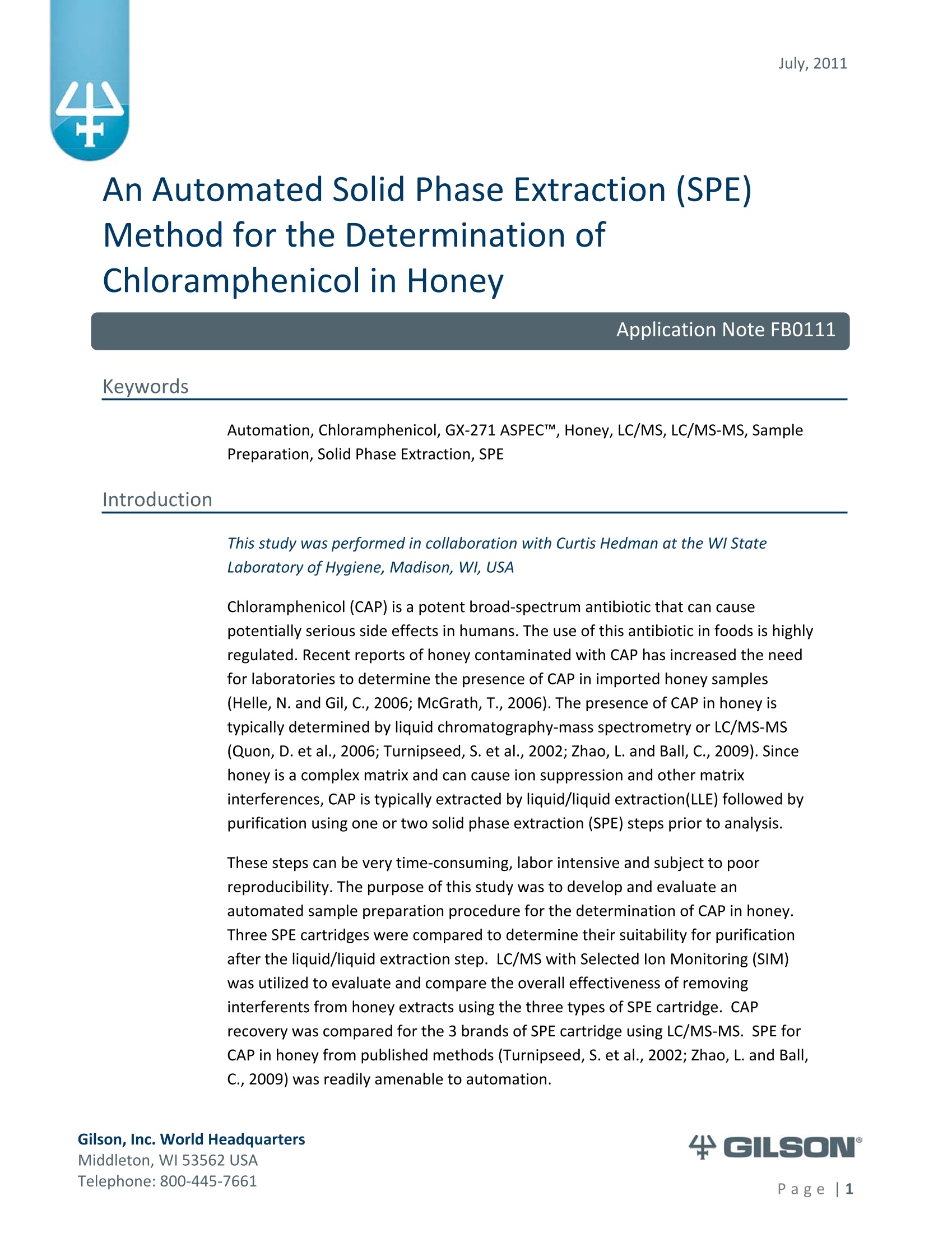
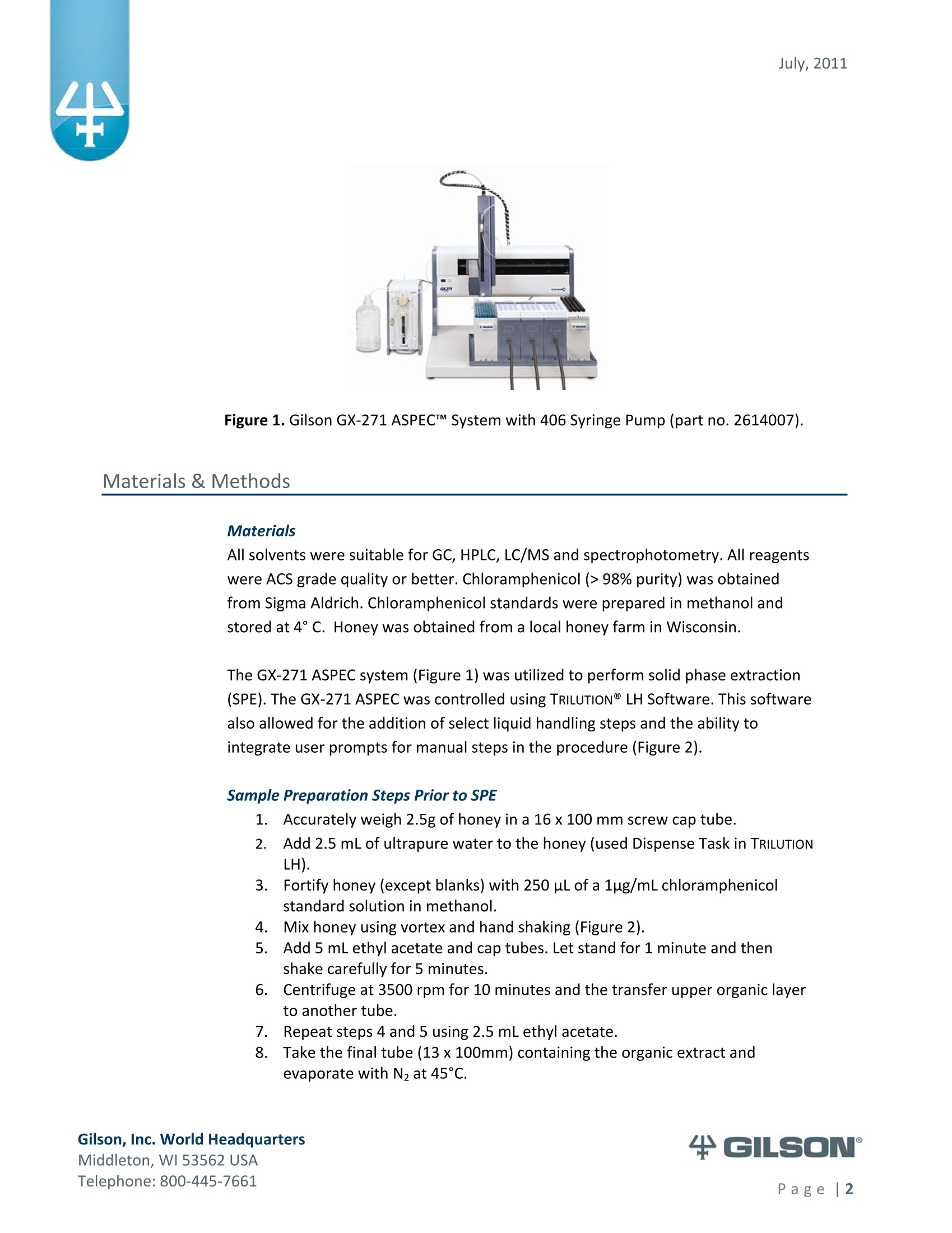
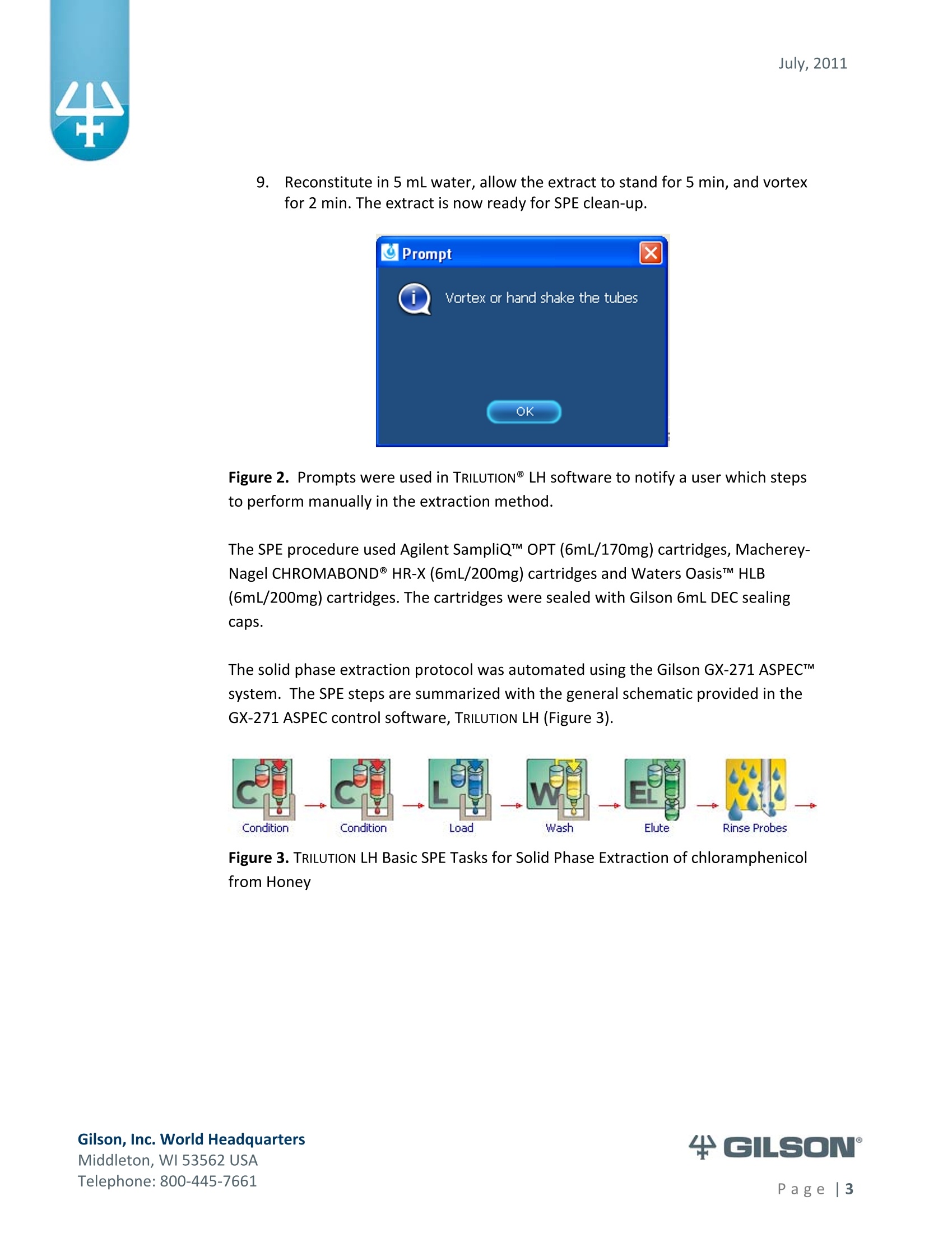
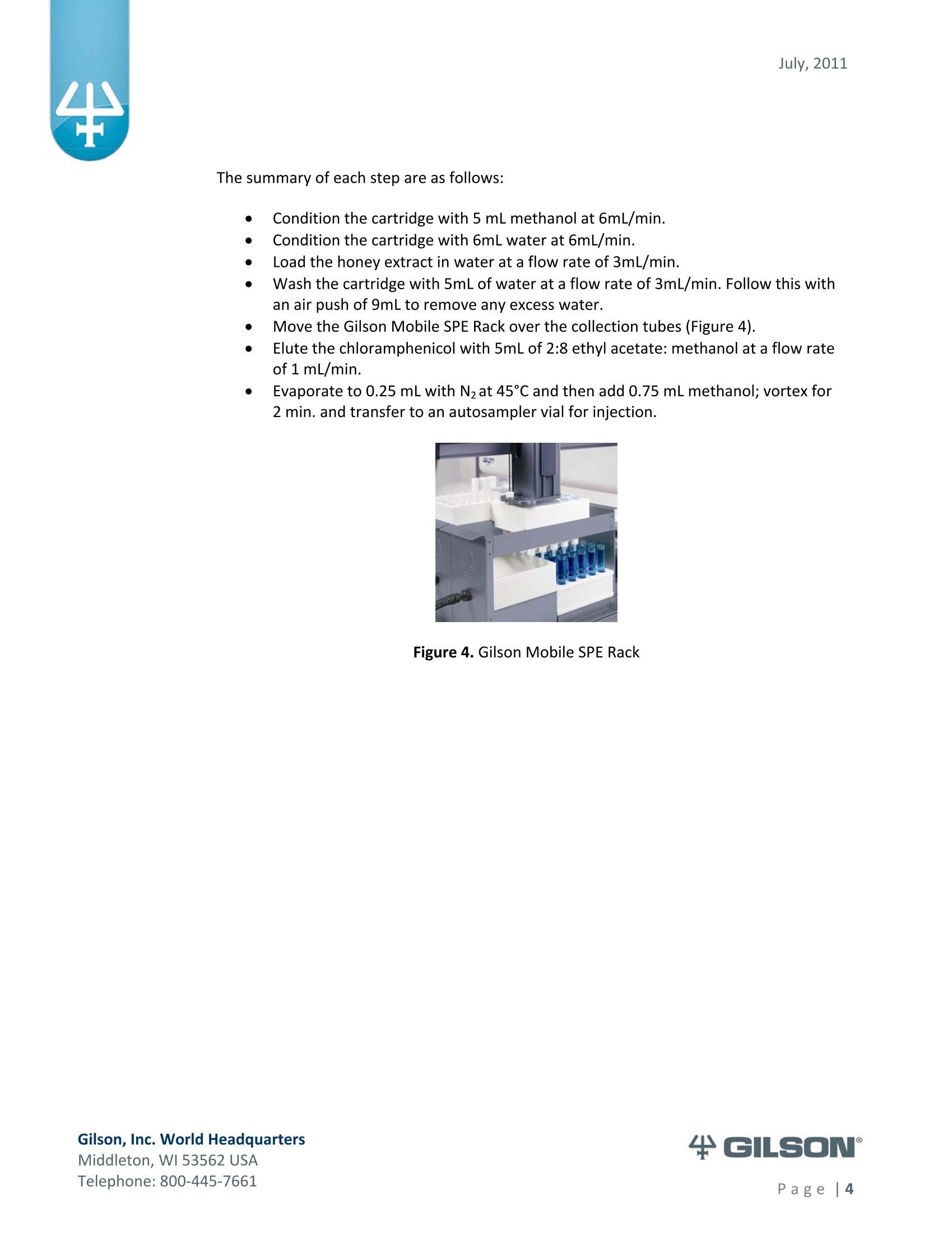
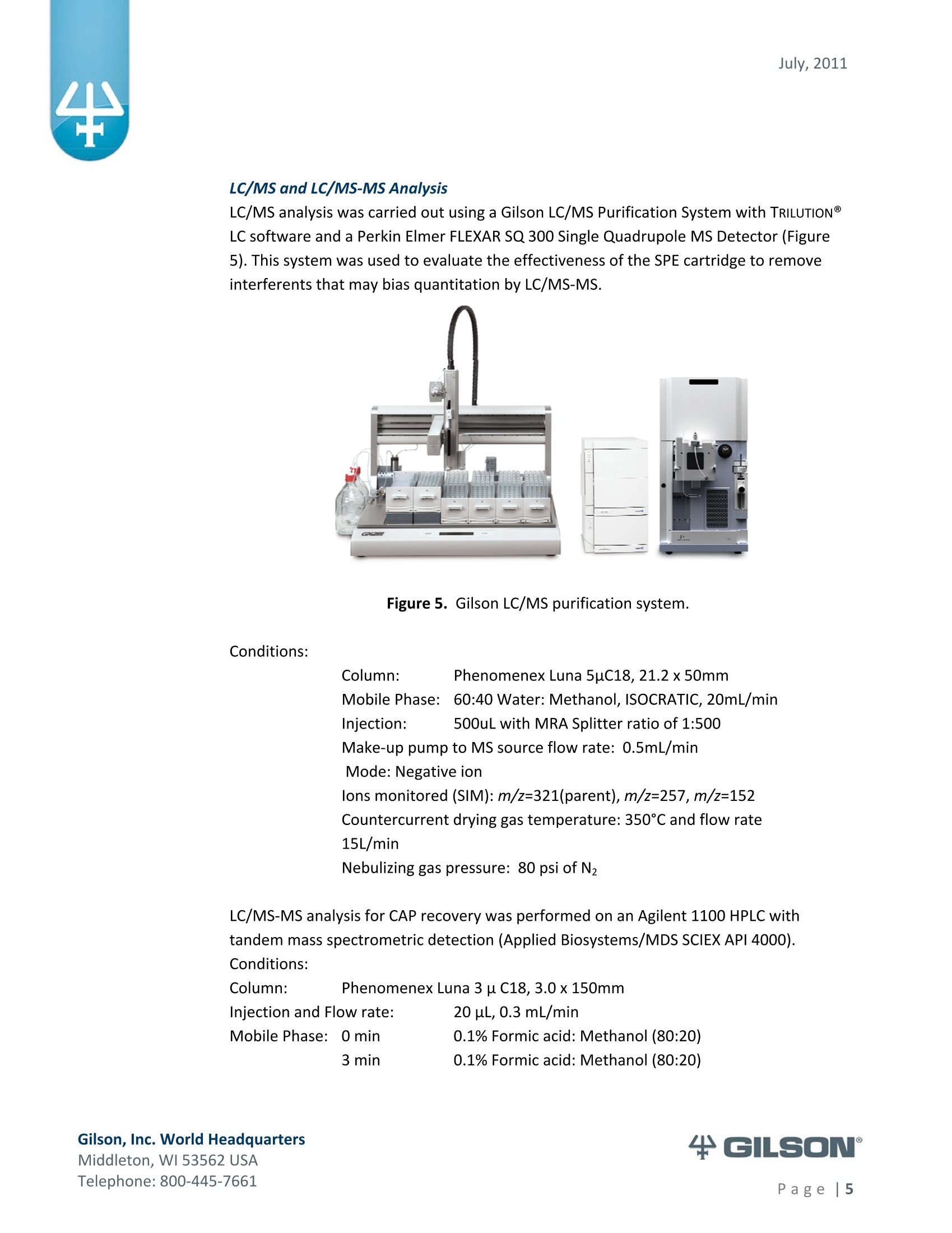
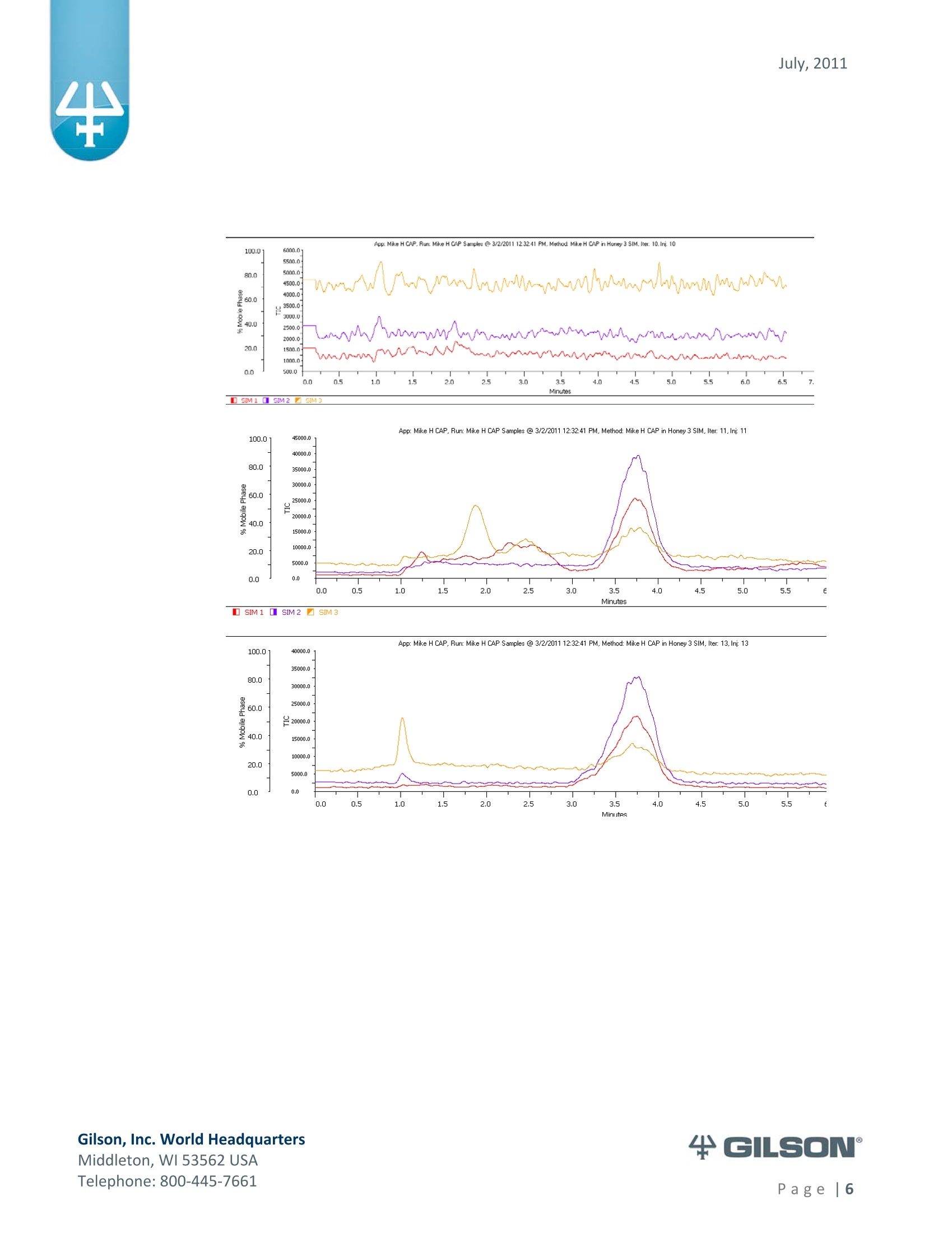
还剩4页未读,是否继续阅读?
香港华运有限公司为您提供《Honey中Chloramphenicol检测方案(固相萃取仪)》,该方案主要用于蜂蜜中兽药残留检测,参考标准--,《Honey中Chloramphenicol检测方案(固相萃取仪)》用到的仪器有
相关方案
更多









